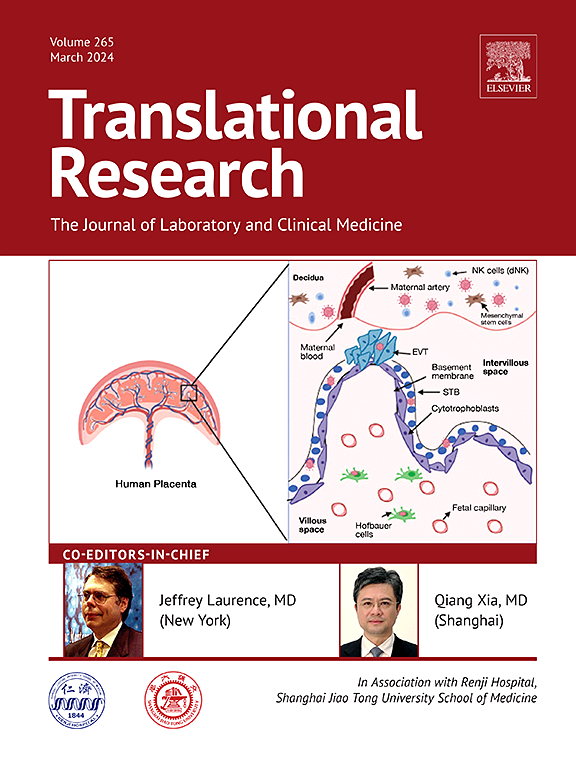PHGDH通过调节YB1/ slc7a11介导的足细胞铁下垂来缓解DKD。
IF 5.9
2区 医学
Q1 MEDICAL LABORATORY TECHNOLOGY
引用次数: 0
摘要
糖尿病肾病(DKD)是终末期肾脏疾病的主要病因,但其发病机制尚不完全清楚。下垂铁与DKD进展有关;然而,其监管机制仍不清楚。磷酸甘油酸脱氢酶(PHGDH)是丝氨酸生物合成的关键酶,在DKD的发展中研究很少。为了阐明PHGDH在铁下垂中的作用及其在足细胞和DKD中的潜在机制,我们进行了这项研究。我们的研究结果表明,PHGDH缺乏加剧足细胞损伤,以细胞骨骼紊乱为特征,并促进足细胞和DKD肾组织中的铁下垂。相反,PHGDH过表达可减轻DKD小鼠足细胞损伤,减轻铁下垂,改善肾功能。在机制上,我们发现PHGDH通过调节SLC7A11(一种关键的铁凋亡相关蛋白)的表达来介导铁凋亡。具体来说,PHGDH通过抑制与k48相关的Y-box结合蛋白1 (YB1)的泛素化和降解来稳定Y-box结合蛋白1,从而增强SLC7A11 mRNA的稳定性和表达。总之,我们的研究揭示了一种新的PHGDH-YB1-SLC7A11调节轴,它负责抑制铁下垂,保护足细胞和肾损伤。我们的研究结果揭示了DKD中铁下垂的分子机制,并强调了PHGDH作为减轻铁下垂介导的肾损害的治疗靶点。本文章由计算机程序翻译,如有差异,请以英文原文为准。
PHGDH alleviates DKD by regulating YB1/SLC7A11-mediated ferroptosis in podocytes
Diabetic kidney disease (DKD) is a main cause of end-stage renal disorder, yet its pathogenesis is still incompletely understood. Ferroptosis has been implicated in DKD progression; however, its regulatory mechanisms remain unclear. Phosphoglycerate dehydrogenase (PHGDH), a key enzyme in serine biosynthesis, has been minimally studied in DKD development. To elucidate the roles of PHGDH in ferroptosis and its underlying mechanism in podocytes and DKD, we conducted this study. Our findings demonstrate that PHGDH deficiency exacerbates podocyte injury, characterized by cytoskeletal disorganization, and promotes ferroptosis in both podocytes and DKD renal tissues. Conversely, PHGDH overexpression alleviates podocyte injury, reduces ferroptosis, and improves renal function in DKD mice. Mechanistically, we identified that PHGDH mediates ferroptosis by regulating SLC7A11 expression, a key ferroptosis-related protein. Specifically, PHGDH stabilizes Y-box binding protein 1 (YB1) by inhibiting its K48-linked ubiquitination and degradation, thereby enhancing SLC7A11 mRNA stability and expression. In conclusion, our study reveals a novel PHGDH-YB1-SLC7A11 regulatory axis that is responsible for suppressing ferroptosis and protecting against podocyte and renal injury in DKD. Our findings shed new light into the molecular mechanism underlying ferroptosis in DKD and highlight PHGDH as a therapeutic target for mitigating ferroptosis-mediated renal damage.
求助全文
通过发布文献求助,成功后即可免费获取论文全文。
去求助
来源期刊

Translational Research
医学-医学:内科
CiteScore
15.70
自引率
0.00%
发文量
195
审稿时长
14 days
期刊介绍:
Translational Research (formerly The Journal of Laboratory and Clinical Medicine) delivers original investigations in the broad fields of laboratory, clinical, and public health research. Published monthly since 1915, it keeps readers up-to-date on significant biomedical research from all subspecialties of medicine.
 求助内容:
求助内容: 应助结果提醒方式:
应助结果提醒方式:


